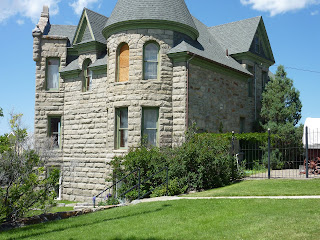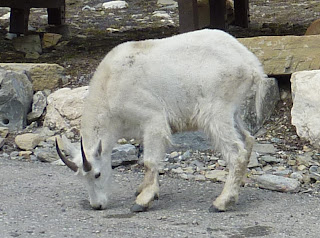We arrived in the Black Hills of South Dakota on the last day of the Sturgis Motor Cycle Rally. There were thousands of bikes on the road heading home and the weather was not friendly. When ½ inch hail started to fall, the brave bareheaded boys of the motorized two-wheelers received a quick lesson in the prudence of helmet wear. They were tattered and bruised as they huddled under underpasses … and, apparently, recounted the beauty of the open road … with the wind (and hail) in your face ….
The hail was so loud we couldn’t even hear each other in the coach and we were yelling! Most people pulled over, I continued driving (slowly) and drove out of the mess into sunny skies. That’s what the weather is like here … sudden, unpredictable, beautiful, and treacherous! One moment it will be sunny, the next a downpour, then hail, then rainbows, then lightning and thunder, then sunshine again … really wonderful stuff!
Our favorite tourist site in the Black Hills is the Crazy Horse monument. It is funded solely with private dollars and is the work of one man and his family in cooperation with the Native Americans in the region, Sioux, Northern Cheyenne, Dakota. The monument is around 10 times larger than Mount Rushmore and is a work in progress. This is what it looks like now.
This is what it will look like when completed.
In addition to the monument the site has a really wonderful Native American museum, sculpturer’s house, Native arts and crafts show, etc.
We did visit Mt. Rushmore … it is obligatory for the tourist. I remember visiting the place as a teen in the early 60s. It was really awe inspiring, huge, and bigger than life… a monumental feat of good ol’ American ingenuity and hard work. When we arrived this time at this National Park we were charged $11 bucks for parking … that’s right the visitor now has to pay for parking at our national park. The parking lot is a big-city three story parking structure that belongs in New York City … not in the Black Hills. It also means that you have to walk a lot further to see the mountain. We came at night and sat through the “show” … a video show of the four presidents’ accomplishments (we used to just learn this stuff in school and didn’t need a multimedia show to tell us who they were or what they had done). At the end of the show they light up the faces which is nice to see. Then the crowds converge on the gift shop … which is the size of a small Walmart … The mountain has become a commercialized modern mess … too bad! Did I mention a visit to the Crazy Horse monument? Here are the obligatory pictures.
We took a drive one day and shot this picture from a pullout off the road. Here is the Mt. Rushmore we were looking for … calm, serene, majestic, and speaking loudly without making any noise!
On that same drive we found a place for Purple Pie … we are always on a quest for the ultimate piece of pie. On the outside, this place was cool … unfortunately, the pie was just ok … nevertheless, we felt obligated to give it the complete pie test … and clean our plates.
A much less visited National Park in the area is Wind Cave National Park. We took a 1.25 mile tour of the underground. The pictures I took don’t really do it justice … It was magnificent, educational, and just plain cool (literally and figuratively).
Anywhere you go in the Black Hills wildlife is plentiful and interesting.
We splurged for dinner at a Chuckwagon Supper place, complete with tin plates, live music, and of course, this guy!
In fact, we liked the area so much we are now citizens of South Dakota!
Until next time … keep doing what you love!











































